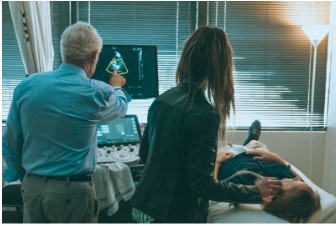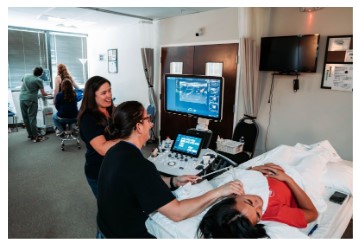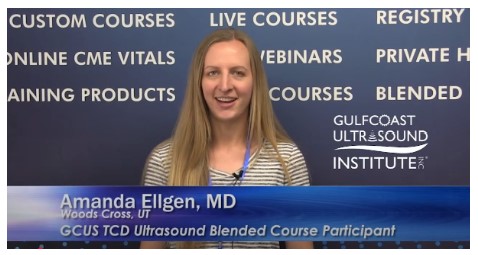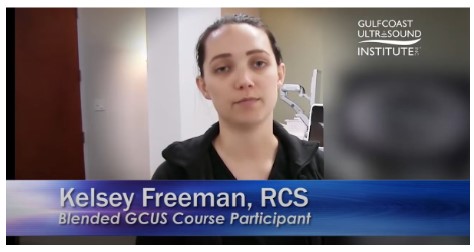Gain hands-on experience and theoretical knowledge to excel in
vascular ultrasound imaging.

Transcranial Doppler (TCD) at Gulfcoast Ultrasound Institute
Why Vascular Ultrasound Training is Essential
Vascular ultrasound plays a critical role in diagnosing and managing various vascular conditions. Its applications include detecting blood clots, monitoring blood flow, and assessing vascular diseases. This non-invasive imaging technique is pivotal in identifying blockages, narrowing of vessels, and other abnormalities that could lead to serious health complications.
Accurate vascular imaging is essential for effective patient care. It ensures timely diagnosis, guides treatment plans, and improves outcomes by enabling healthcare providers to make informed decisions. Comprehensive training equips practitioners with the skills needed to perform and interpret these scans with precision, ultimately enhancing the quality of patient care.
Types of Vascular Ultrasound
Carotid Duplex Ultrasound
This ultrasound modality evaluates the carotid arteries in the neck, which supply blood to the brain. It combines traditional ultrasound imaging and Doppler evaluation to assess blood flow and detect blockages or narrowing (stenosis) that may lead to strokes.
Venous Duplex Ultrasound
Used to assess veins, especially in the legs, to detect conditions such as deep vein thrombosis (DVT). The test helps visualize blood flow and identify blood clots, vein valve issues, or venous insufficiency.
Arterial Duplex Ultrasound
This ultrasound examines peripheral arteries in the limbs to detect peripheral artery disease (PAD). It measures the speed and direction of blood flow to detect blockages, narrowing, or plaque buildup in the arteries.
Abdominal Aortic Ultrasound
Focused on the abdominal aorta, this ultrasound is used to detect aneurysms, dissections, or blockages. It helps identify dangerous bulging or enlargement of the aorta that could lead to life-threatening rupture if untreated.
Renal Artery Ultrasound
Used to evaluate the arteries supplying blood to the kidneys, this test detects narrowing (stenosis) or blockages that can cause high blood pressure or reduce kidney function.
Transcranial Doppler (TCD) Ultrasound
This specialized ultrasound examines the blood flow in the brain’s major arteries. It’s used to detect conditions like emboli, vasospasms after subarachnoid hemorrhage, or assess for stroke risk.
Ankle-Brachial Index (ABI) with Ultrasound
This non-invasive test compares blood pressure in the ankle and the arm to diagnose PAD. Duplex/Color Flow Ultrasound can assist in visualizing arterial flow for a more accurate assessment.
Endovenous Ablation
This is a minimally invasive procedure that uses heat from a laser or Radiofrequency energy to close off veins when treating venous insufficiency.
Mesenteric Artery Ultrasound
This ultrasound evaluates arteries supplying blood to the intestines. It's used to detect stenosis that may lead to chronic abdominal pain after eating, known as mesenteric ischemia.
Equipment Used for Vascular Ultrasound
Ultrasound Machine
- High-Resolution Ultrasound System: A machine capable of producing detailed images with adjustable frequency settings (typically 5-15 MHz for vascular studies).
- Color Doppler and Spectral Doppler Capabilities: Essential for assessing blood flow velocity, direction, and patterns in arteries and veins.
- Pulse Wave and Continuous Wave Doppler: To measure the speed, direction, and volume of blood flow accurately.
Transducers (Probes)
Different transducers are used based on the type of vascular ultrasound exam:
- Linear Array Transducer (5-15 MHz): Ideal for superficial vessels like carotid arteries, peripheral veins, and arteries.
- Curvilinear (Convex) Transducer (2-5 MHz): Used for deeper structures like abdominal aorta, mesenteric vessels, and renal arteries.
- Phased Array Transducer (2-5 MHz): Best for transcranial Doppler (TCD) studies and deep, narrow access points.
Ancillary Equipment
- Blood Pressure Cuffs: For Ankle-Brachial Index (ABI) assessments.
- Gel: Essential for reducing air between the probe and skin, ensuring clear images.
- Sterile Sheaths and Gel: Required for invasive procedures or when performing scans on open wounds.
- Positioning Aids: Wedges, pillows, or adjustable tables to ensure optimal positioning for vascular access and imaging.
Learning to Perform Vascular Ultrasound

How Gulfcoast Ultrasound Institute Vascular Ultrasound Training Works
At Gulfcoast Ultrasound Institute, we provide a comprehensive educational experience through our traditional live courses and blended learning formats, ensuring flexibility and depth of learning. Additionally, online courses, custom on-site group training, and private hands-on training are available. For those preparing to take a national certification exam, Registry Exam preparation materials are available offering a greater than 97% pass rate.
- Classroom-Based Instruction: Participants engage in interactive lectures led by expert instructors with extensive clinical experience. These sessions cover essential principles, techniques, and protocols, ensuring a strong theoretical foundation.
- Hands-On Training with State-of-the-Art Equipment: Learners gain practical skills using cutting-edge ultrasound machines. Guided by expert instructors, participants perform real-time scanning on live standardized patient models, simulating authentic clinical experiences. Selected courses such as MSK ultrasound incorporate scanning un-enbalmed human cadaveric specimens for performing interventional procedures under ultrasound guidance.
- Real-Life Case Studies and Patient Simulations: Our courses incorporate diverse case studies to reinforce learning.
- Continuing Education Credits: Upon successful course completion, participants earn continuing education credits, supporting their professional development and maintaining credentialing standards.
- Certification: Certification requirements in vascular ultrasound vary based on an individual's educational background. Sonographers can obtain certification through the American Registry for Diagnostic Medical Sonography (ARDMS) or Cardiovascular Credentialing International (CCI), while physicians can obtain certification through the Alliance for Physician Certification & Advancement (APCA) as well as other certifying agencies. Physician requirements for certification vary state by state.
This structured approach ensures that participants leave with confidence, competence, and the practical knowledge necessary for clinical excellence in vascular ultrasound.
Frequently Asked Questions
Q: What prerequisites are required for vascular ultrasound training? A: While prior ultrasound experience is beneficial, it is not mandatory. Our courses are designed for both beginners and experienced healthcare professionals. Foundational courses cover essential concepts to ensure all participants build a strong understanding before advancing.
Q: Can I earn CME credits from these courses? A: Yes, Gulfcoast Ultrasound Institute is directly accredited through the Accreditation Council for Continuing Medical Education (ACCME) and as such, is able to award AMA PRA Category 1 Credit(s)™?with all our vascular ultrasound courses. These credits support professional development and credential maintenance.
Q: Do I need prior medical experience to enroll? A: Gulfcoast Ultrasound Institute Is a Continuing Medical Education (CME) School and courses are designed for those who already hold an Allied Health Degree or Higher. If you are looking into cross training into Ultrasound, we recommend checking with the ARDMS, and CCI (All healthcare professionals), or APCA (Physicians Seeking RPVI Certification) for exam prerequisites to verify your educational background. If you are looking to get into the medical field for the first time with a focus on Sonography, we recommend checking out our article on How to Become a Sonographer. .
Q: What is the format of the training courses? A: We offer both traditional format live courses and blended learning options. Live courses involve in-person, lectures and hands-on training, while blended formats combine online learning with live hands-on sessions for maximum flexibility.
Q: How long does it take to complete a vascular ultrasound course? A: Course lengths vary depending on the program. Courses range from 1-5 days depending on format and specialties.
Q: Will I receive a certificate after completing the course? A: Yes, all participants receive a certificate documenting the amount of earned AMA PRA Category 1 Credit(s).™? acknowledging their participation and achievement in the course.
Q: Are there opportunities for one-on-one instruction? A: Absolutely. While our regularly scheduled cours es offer the lowest participant to instructor ratio (never to exceed 3:1) we also offer Private one-on-one Hands-On training.
Q: What types of ultrasound equipment will I train on? A: Participants will use state-of-the-art ultrasound machines, mirroring equipment commonly used in clinical settings. This ensures relevant, real-world training experiences.
Q: How do I register for a course? A: Registration is simple through our website. Choose your preferred course, complete the registration form, and secure your spot. Our team is available for any assistance during the process.
Testimonials

"I really appreciated that the course was mostly hands-on, and the instructors were very personable." – Amanda Ellgen, MD (Transcranial Doppler (TCD) course attendee)
Watch the testimonial here

"The instructors are very helpful and had answers for all of our questions. We had plenty of hands-on time." – Kelsey Freeman (Vascular Ultrasound Course Attendee)
Watch the testimonial here
FREE Vascular Ultrasound Resources (Click to View)

Location & Contact
Visit Gulfcoast Ultrasound Institute
- Address: 111 2nd Ave NE, #800, St. Petersburg, FL 33701
- Phone: 727-363-4500
- Email: learn@gcus.com
Ready to Advance Your Career in Vascular Ultrasound?
Call Gulfcoast Ultrasound Institute at 727-363-4500 for all your ultrasound training needs! Conveniently located at 111 2nd Ave NE, #800, St. Petersburg, FL 33701, we’re here to help you excel in vascular ultrasound.






